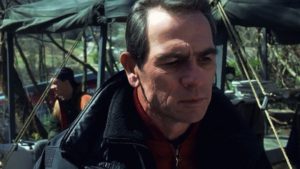by James Scott Bell
@jamesscottbell
Some years ago I had the chance to meet and listen to the late Stephen J. Cannell. Cannell was, of course, the television wunderkind who created such shows as The Rockford Files, Baretta, The A-Team, 21 Jump Street, and others. He wrote at least 450 filmed television scripts. The guy had a Midas typewriter.
In the 90s he started writing crime fiction, then a series of books featuring LAPD detective Shane Scully.
So Cannell was on this panel with Robert Crais and T. Jefferson Parker. Someone asked him a writing question, and Cannell said something to the effect that he always asks, “What’s the bad guy doing?”
Even when the bad guy wasn’t “onstage,” Cannell would be pondering: “What’s the bad guy doing?”
It’s a great question! We writers seldom give the offstage players any mind. I’ve written before of the power of the “shadow story.” What’s the bad guy doing? is one of the key questions to ask in that regard.
Note: you don’t have to be writing about a true “bad guy” to ask this question. It applies to any antagonist.
Let’s say you were writing the novel that became the movie The Fugitive, starring Harrison Ford and Tommy Lee Jones (in reality the movie was based on the hit 1960s TV series starring David Janssen, created by Roy Huggins). In the movie Jones plays U.S. Marshal Sam Gerard. He’s not a bad guy. He is in fact a good guy who happens to be tasked with nabbing Dr. Richard Kimble and sending him back to Death Row.
Let us further suppose that you were writing the novel in First Person or Limited Third Person POV (where you stay with one character’s perspective throughout). You would be in Kimble’s head as he comes home to confront the one-armed man who murdered his wife. Then would come the trial and Kimble’s wrongful conviction.
Next, the prison bus mishap, the train crash, the escape! Then Kimble struggles through the night with his wound and his prison uniform. And you’d come to the next morning when he sneaks into the rural hospital to dress his wound, get some civvies, shave, and get out of there without being noticed.
All very tense. Good job, novelist!
Finally Kimble gets out of the hospital, but not before he is recognized by a wounded prison guard from the bus. To keep the guy quiet Kimble pushes an oxygen mask on his face. And as the paramedics rush the guard inside, Kimble tells them to let the attending doctor know the guy has a puncture in his upper gastric area.
Which causes one of them to ask, “How the hell does he know by looking at him?”
Kimble then hops in the ambulance and takes off.
Nice scene, there, writer! The opening act has been awesome!
But then you come to your project the next day and can’t figure out what to write next. If you’re a pure pantser, of course, you can write about anything. So you do a scene where Kimble falls into a giant hole that spits takes him back in time to the Battle of Little Big Horn. There he tries to save as many wounded as possible until…
Oh bollix, you think. I wish I’d done some outlining! And I wish I knew why I keep using the word bollix!
Now what?
Ask the Cannell question! “Hmm, what’s my antagonist doing while Kimble is at the hospital?”
 The nice thing about the movie is we get to see it. We cut back to Gerard at his command post, making plans. We see what kind of team and resources he has assembled.
The nice thing about the movie is we get to see it. We cut back to Gerard at his command post, making plans. We see what kind of team and resources he has assembled.
So back to the hospital. You’re thinking about what Sam Gerard is doing. You imagine him at the crash site, with his team gathered around him. Then one of his people runs up and says, “Hey, we just got a report. Kimble stole an ambulance!” What would Gerard do next?
Order a chopper! Let’s move!
Which gives you the idea for the next scene in your novel. Kimble looks up and sees he’s being chased from the air!
Way back when I was first trying to learn this craft of ours, and writing copious notes on what I learned, I jotted this down: Most of the craft of fiction is knowing what questions to ask at what time.
I still think that’s a pretty good insight. And What’s the bad guy doing? is a darn good question.
Do you know what yours is doing?


Oh bummer. I didn’t realize Mr. Cannell had passed away. I spent many an hour in the 80’s watching his work—and seeing that iconic page come out of the typewriter and form a “C”. The Greatest American Hero is the show that comes most readily to mind.
And asking what the bad guy is doing sounds like a great wait to keep from writing yourself into a corner.
Oye. That’s ‘great way’.
More from Cannell regarding the bad guy:
Because Act Two is the hardest act to plot, most people give up on their ideas in Act Two; “This isn’t working.” “This idea sucks.” Most of the time the reason we break down plotting Act Two, is that we tend to “walk” with the hero because we identify with the protagonist. We walk through the story inside his or her head.
Once we get past the complication and are into Act Two, we sometimes get stuck. “What do I do now?” “Where does this protagonist go from here?” The plotting in Act Two often starts to get linear (a writer’s expression meaning the character is following a string, knocking on doors, just getting information). This is the dullest kind of material. We get frustrated and want to quit.
Here’s a great trick: When you get to this place, go around and become the antagonist. You probably haven’t been paying much attention to him or her. Now you get in the antagonist’s head and you’re looking back at the story to date from that point of view.
“Wait a minute… Rockford went to my nightclub and asked my bartender where I lived. Who is this guy Rockford? Did anybody get his address? His license plate? I’m gonna find out where this jabrone lives! Let’s go over to his trailer and search the place.” Under his mattress maybe the heavy finds his gun (in Rockford’s case, it was usually hidden in his Oreo cookie jar). His P.I. license is on the wall. Now the heavy knows he’s being investigated by a P.I. Okay, let’s use his gun to kill our next victim. Rockford gets arrested, charged with murder. End of Act Two.
See how easy it works? The destruction of the hero’s plan. Now he’s going to the gas chamber.
Plot from the heavy’s point-of-view in Act Two; it is an invaluable tip.
Great advice. And of course, to figure out what the bad guy’s doing, you have to know him, and that means you’ve fleshed him out into a real character.
I love this. Thank you, Jim. Now I’m off to see what my bad guy is doing.
This is great information. I keep a spread sheet of where the major characters are and what they’re doing. I started doing it to make sure the time line and character intersections in the story worked right, but it also kept me in mind of what everyone was doing off stage — not just smoking and drinking coffee. Thank you.
On the road, so keep up the conversation!
I’m stuck on the ending, not a second scene. The question “What’s the bad guy doing” is exactly what I needed for the ending. I thank you. Also, love the shows Cannell wrote. I didn’t know he’d passed on (either that or I’d forgotten). He was also dyslexic, which did not slow him down!
Thanks for this, James!
Not to belittle the topic in any way, because asking questions is the way I keep my own books moving (although my most frequently asked question is “Why?”), but I got totally sidetracked by “bollix” and ended up here: https://melhealy.wordpress.com/2014/05/26/bollocks-bollix/
I always suggest to my writing students that they write the backstory of the bad guys so the motives and actions will make sense, and then write the plot from their viewpoint so they don’t come across as author plot puppets when the author writes the story.
Ah, now that you mention it…
Thank you, Mr. B, for once again providing me with a “Duh” moment…
🙂
And now that I cogitate on it, this offers a “creative” alternative to the alleged, mythical writer’s block ~ when stuck on the protag, see the antag is up to…
Sunday TO DO List:
Get coffee
Read Bell’s essay on The Kill Zone
Re-Write first part of Act II
Super! Two insights in one post. Mr. Cannell’s “What’s the bad guy doing?” and your own “Most of the craft of fiction is knowing what questions to ask at what time.” Good going, Mr. Bell. I’ve written them both in my ever-growing notebook on How To Write Fiction. Maybe someday I’ll actually learn this craft and art. Posts like this help. A lot.